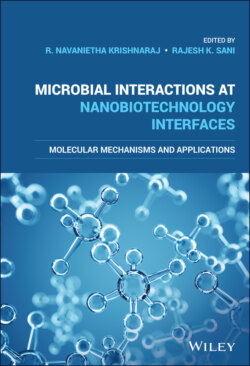Читать книгу Microbial Interactions at Nanobiotechnology Interfaces - Группа авторов - Страница 56
1.13 Effects of Functionalization on the Antimicrobial Property of Nanomaterials
ОглавлениеAlthough several antimicrobial agents have been developed so far, they are still not able to meet the required therapeutic index. Even though NMs are well‐known for their renowned antibacterial activities, their application is still limited due to their certain nonspecific toxicity. In order to improve antimicrobial therapeutic index and reduce the nonspecific toxicity, biofunctionalization or chemical modification of NPs with bioactive molecules has emerged as a plausible and promising solution. The selection of a NM along with a rational biomolecule is likely to improve the applicability of the composite NM.
Several techniques have been employed to functionalize NMs such as covalent bonding (Veerapandian et al., 2010), non‐covalent bonding (Knopp, Tang, & Niessner, 2009), simple coating or deposition (Bunker et al., 2007), stober technique (Luckarift et al., 2007), coupling reaction‐assisted immobilization (Wang et al., 2004), reverse micelle and sol–gel technique (Yang et al., 2004). Photo‐Fenton oxidation, radiofrequency plasma, and vacuum‐UV radiation methods have been employed for click chemistry (Mazille et al., 2010). Protein and peptides, especially those with cationic nature, have been found to be toxic against many drug‐resistant microbes. The antimicrobial property of these proteins or peptides depends on the ability to form α‐helical or β‐sheets or α‐helical bundles because of the interaction with anionic bacterial cell wall and self‐association in solution state (Fernandez‐Lopez et al., 2001; Oren et al., 2002). In an earlier study, the antibacterial activity of hen egg lysozyme‐conjugated polystyrene latex NPs against Micrococcus lysodeikticus was studied. It was observed from the study that antimicrobial property of cationic NP‐conjugated enzyme was twice that of free enzyme (Satishkumar & Vertegel, 2008). Similar to proteins, carbohydrate also enhances the antimicrobial property of NMs. Veerapandian et al. (2010) reported that the glucosamine (amino sugar) functionalization of silver NPs improved the antimicrobial property against eight Gram‐positive and Gram‐negative bacteria. The functionalization of glucosamine over silver NPs enhanced the interaction and penetration of NPs into bacterial cell, which improved the antibacterial activity of glucosamine‐functionalized silver NPs (Veerapandian et al., 2010). Next to proteins and carbohydrates, lipids also possess antimicrobial property and they are part of innate immune system. The common antimicrobial lipids found in skin cells of human involve sphingosine, dihydro‐sphingosine, 6‐hydrosphingosine, sapienic– acid, and lauric acid (Drake et al., 2008). A study reported that oleic acid‐stabilized silver NPs exhibited highest antimicrobial property against E. coli and S. aureus. It was observed that the hybrid material produced a quick response over E. coli than S. aureus. The stabilization of oleic acid improved the permeability of the NP inside the bacterial cell, which inhibited or altered the cellular transport across the bacterial cell and resulted in bacterial cell death (Le et al., 2010). Apart from other biomolecules like proteins/peptides, carbohydrates, lipids, and DNA, the NMs have been functionalized with antibiotics to improve their antibacterial effect through synergistic effect. It was reported earlier that the introduction of antibiotics such as kanamycin, erythromycin, ampicillin, and chloramphenicol along with silver NPs has enhanced the antibacterial property of silver NPs (Fayaz et al., 2010). The ampicillin silver NP complex has shown the highest antimicrobial effect over other complexes. Here, the strong van der Waals attraction force caused the interaction of NP with the bacterial cell surface. This interaction led to the lysis of cell wall and subsequent penetration of NP into cell where it intervened with the DNA unwinding and effected in the death of bacterial cell (Fayaz et al., 2010). In another study, Jaiswal and Mishra (2018) showed that the functionalization of silver NPs with curcumin improved the antimicrobial properties and also reduced the cytotoxicity of the silver NPs against human keratinocytes (Jaiswal & Mishra, 2018). However, in recent years a lot of work is going on with functionalization of NMs and the basic understanding of the interaction of the bacterial system with functionalized NPs. Better understanding of mechanism of functionalized NMs along with suitable nano‐bio interface phenomenon will guide us to develop more standard design criteria to develop advanced materials with peculiar and desired properties.
